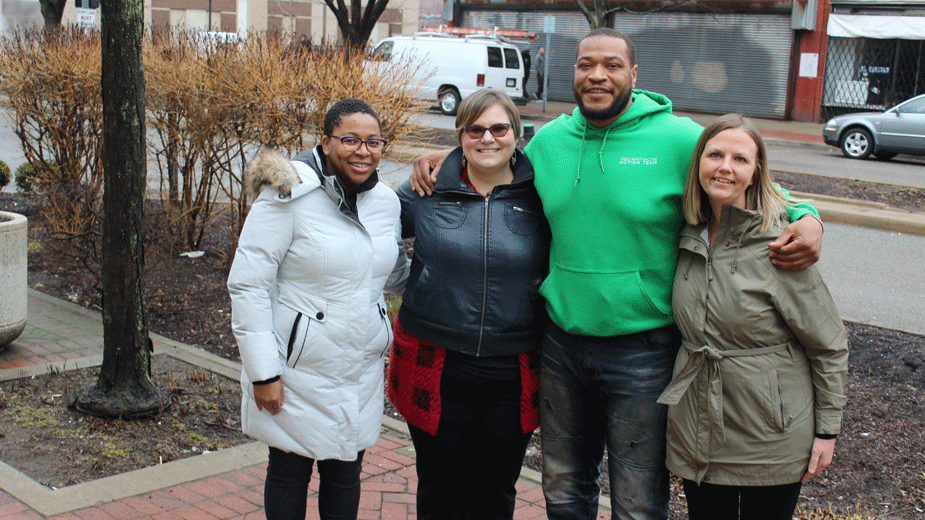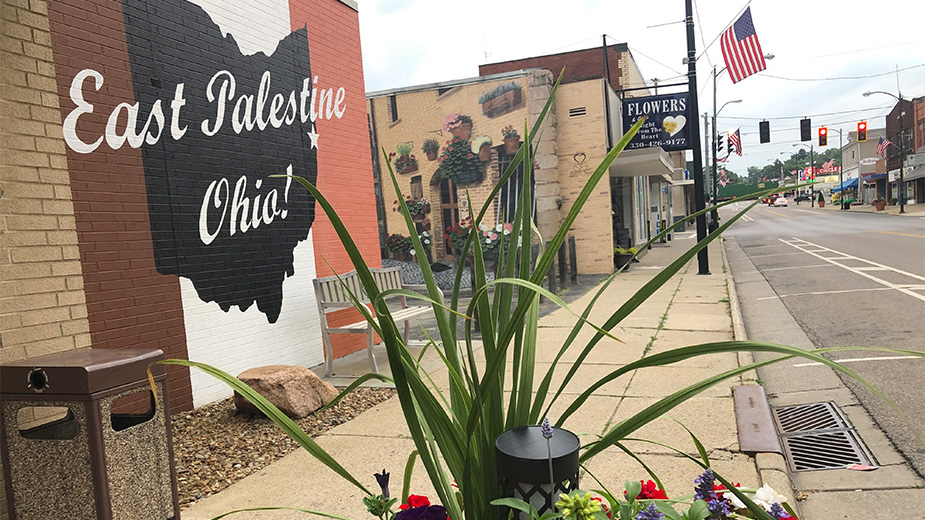Fresh Coast Seeks a Greener Youngstown
YOUNGSTOWN, Ohio – Downtown Youngstown is covered with tons of concrete. With miles of sidewalks, vast slabs on Federal Plaza and well-traversed roads, it’s a crucial element of the infrastructure.
But when it rains, all that concrete surface can cause problems. Water runs off the sidewalks and roads into storm drains, taking with it the trash, debris, automotive fluids and anything else that’s loose. When that debris can’t get to the drains, which is often, it piles up along curbs and in chuckholes as water pools and floods parking spaces.
At a spot in front of the former State Theatre, Youngstown CityScape associate director Phil Kidd points to a problem area. On a bump out – a portion of sidewalk that extends into the street, usually near a corner – is a space where a tree once stood. The space has since been covered with bricks and cigarette butts, sticks, leaves and loose papers piled deep along the curb. A grate sits in the middle of a handicap parking spot.
“This particular corner will flood all the way out to the grate and overflow onto the sidewalk,” he explains. “So you have the space that could be designated for green infrastructure combined with a flooding issue.”
All the water that flows into the storm drains goes into the combined sewer, which also collects residential and business wastewater. Under normal conditions, the water in the combined sewer system is diverted to a wastewater treatment plant and re-enters the water cycle.
If there’s too much rain, however, the system is taxed and water from the sewage system ends up in waterways. It’s that failure that caused Mill Creek MetroParks to close access to its waterways in the summer of 2015.
“This combined sewer overflow issue is something nearly 800 cities around the country are dealing with. Many of those are industrialized Rust Belt cities because we have that infrastructure that was built a hundred years ago,” says April Mendez, vice president of programs for Fresh Coast Capital.
Fresh Coast, a green infrastructure consulting company based in Chicago, arrived here in 2015 as part of a partnership with Youngstown Neighborhood Development Corp. and the Department of Housing and Urban Development. For that project, the group planted trees in three city parks and took charge of their maintenance as well.
Among the other cities Fresh Coast has served, through its nonprofit arm Fresh Coast Communities, is Peoria, Illinois. There, through a $1 million grant, the group and other partners converted several vacant lots into usable greenspace that helps offset the issues sewer overflow creates.
“It’s a large, vacant parcel that has different elements to it. It has a flowering bioswale, which produces cut flowers residents are trained to harvest and sell, giving them some agribusiness skills,” Mendez says.
For decades, cities like Youngstown have used what’s known as gray infrastructure to deal with rain water, employing drains, pipes and basins to collect and deliver water. Green infrastructure uses plant life to direct and collect water. The soil serves as a water filter, with roots acting as a support system to prevent the dirt from washing away.
Where traditional gray infrastructure carries water – and does that job effectively, Mendez notes – that’s the only thing it does. Green infrastructure, on the other hand, does that and a lot more. In retail areas, for example, customers are more likely to come in, stay longer and spend more money in the store because the greenery adds to the perception of higher value.
“Especially in below-the-poverty-line communities,” says Keland Logan, executive director for The Colony Youngstown, “there are reduced crime rates – reduced gun violence and narcotics violations – because these places are no longer anonymous areas. They’re places that are respected and cared for. The culture of the neighborhood becomes more positive.”
The economic impact of green infrastructure extends beyond what customers are willing to spend in stores. Jobs go along with the planning, installation and maintenance.
Fresh Coast is working on a grant proposal to bring an EPA education program, Engineering is Everywhere, to more people in the city through Youngstown State University and the Youngstown Metropolitan Housing Authority.
“Every investment the city makes in green infrastructure is also an investment in the jobs. It’s a great opportunity to expand the workforce and prepare students for jobs that pay good money,” Logan says.
Since arriving three years ago, Fresh Coast has begun laying the groundwork for the city and organizations to improve green infrastructure. In early March, Fresh Coast and community improvement group The Colony Youngstown partnered to begin a series of workshops around the city.
The purpose was twofold: to educate residents about residential green infrastructure and to collect information for a green infrastructure plan.
As part of a consent decree with the EPA, Youngstown is required to put together a long-term plan to address its stormwater overflow issues. One aspect of that plan includes green infrastructure.
To put together that plan, Fresh Coast has a 45-member steering committee composed of community stakeholders, including representatives from YSU, CityScape, Eastgate Regional Council of Governments, Youngstown Neighborhood Development Corp., several departments at Youngstown City Hall and MS Consultants, which wrote a long-term control plan for the city in accordance with the EPA’s mandate.
As part of that, explains MS Consultants project manager Courtney Boyle, the engineering firm conducted a flow analysis several years ago. In conjunction with Fresh Coast, the data from the workshops will be combined with a new flow analysis.
“That’ll all get tied into the technical piece. We have to take the community input. It may look great here, but it may not make sense to put it there,” Boyle explains. “As part of our predevelopment phase, we have to look at if green infrastructure is even feasible for reducing stormwater flows.”
Adds Mendez: “The first layer is how is water moving and where is it going in Youngstown. Once we know that, we can proactively design it to improve economic growth, improve health outcomes, et cetera. That data is put on top of the technical information.”
Once the analysis and workshops are complete, Fresh Coast will present the plan to City Council. Should it be approved, Fresh Coast will become involved to carry out the plan.
“Our hope is to be a long-term partner, maybe 20 or 30 years, to implement the full plan. Most of that would be built in the first couple of years and then the rest is maintenance,” Mendez says.
Jumping back to downtown, Mendez points to some of the ways green infrastructure could be used. Earlier this year, Downtown Youngstown Partnership, an affiliate of CityScape, received a Neighborhood Success grant from the Raymond John Wean Foundation to plant new trees.
“We plan to work with Fresh Coast to talk about the most impactful location of those trees, what’s the right type of tree and the best practices for those,” says CityScape’s Kidd. “It’s a smaller but practical project that we can do this year in downtown.”
For parking lots, such as the one installed next to the police department, permeable pavers are an option that would allow water to drain better. In the flower beds on each quadrant of Central Square, lowering the beds to ground level would improve drainage. As matters stand, those beds collect only the rain that falls on them. At ground level, such rainfall could be directed toward them, alleviating some flooding issues.
“It has an intent to manage and control stormwater runoff,” Logan says of the green infrastructure possibilities. “That’s the difference between [green infrastructure and beautification]. The intention. It needs to be beautiful, but usable too.”
Pictured: Fresh Coast Capital’s work in Youngstown is led in part by Fresh Coast program coordinator Genese Leach, Fresh Coast Vice President of Programs April Mendez, The Colony Youngstown Executive Director Keland Logan and MS Consultants project manager Courtney Boyle.
Copyright 2024 The Business Journal, Youngstown, Ohio.



